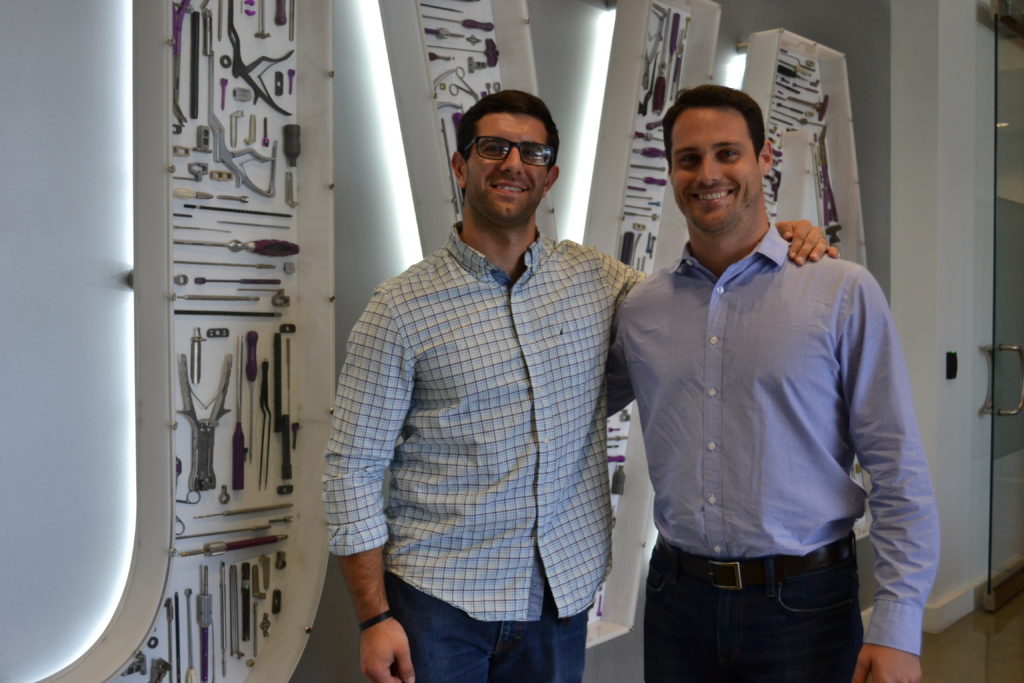Lateral ALIF™ has all the characteristics of a traditional supine ALIF and is specifically designed to access L5-S1, but performed with the patient in the lateral decubitus position. We’re featuring Brigade® Lateral innovators, Mike and Kevin, to give you an inside look into what it’s like helping drive Lateral Single-Position Surgery innovation at NuVasive.

What sparked the need for Brigade Lateral?
- Mike, Marketing: This was primarily spurred on by a market need. We had just launched Lateral ALIF and realized there was room for improvement in our interbody offering to increase the reproducibility and adoption of the technique. Lateral ALIF is extremely valuable to surgeons and their patients, so we wanted to ensure our implants were optimized to take advantage of all the benefits and remove any barriers to surgeons interested in the technique.
- Kevin, Engineering: Brigade Lateral came about from needing an improved PEEK implant designed for the Lateral ALIF procedure. This procedure is driven by the movement to Lateral Single-Position Surgery, which eliminates the need to reposition a patient while addressing pathologies from different approaches.
What were the resources required to develop Brigade Lateral?
- Mike: Resources from engineering, marketing, regulatory, operations such as buyers and planners, and finally budget to move forward. Everyone jumped on board quickly and we started moving forward almost immediately.
- Kevin: The procedural and design requirements from market analysis really kicked this project off. After that, a lot of cross-functional team collaboration really got the project moving.
Sometimes the first idea might not be the best idea. Was the original idea for Brigade Lateral what it is today? If it changed, what necessitated the change?
- Mike: The scope of the project shifted a couple of times based on clinical needs and the team did a great job to adjust. First, we were only going to launch a new implant and no new instrumentation. After discussing with our surgeon partners, we found that this was not the best plan since there were some clear changes we could make to the instrumentation in order to increase the value of the launch. Our engineers worked with us and we found a way to not only optimize new instruments, but streamline the number of instruments needed to help the scrub techs and OR staff during surgery.
Second, we were only planning on having one inserter design. This was in order to keep things moving quickly and design the implant for Lateral ALIF only. Again, after talking with surgeons we found that there may be cases where day-of decisions would have to be made and the case would change from a Lateral ALIF to a Supine ALIF. In this scenario, our one inserter design would not be optimal and it would require the hospital staff to sterilize and prep two other systems in order to meet this need. Instead, we changed the implant slightly and created one new inserter to obviate any need to order in extra trays and systems. This will be a huge benefit not only to surgeons, but also operationally for NuVasive and the hospitals.
- Kevin: I definitely agree with Mike here. The first concept of the implant that we had was iterated a few times based on clinical feedback and surgeon labs. Also, as Mike said, we changed our project scope based off surgeon feedback to include new instrumentation that would help improve the overall surgical procedure as well as improve the operational management.
What was your favorite part about the design and marketing process for Brigade Lateral?
- Mike: I loved the collaboration and willingness to meet the market needs. Many times a team will get de-railed by scope changes but this team took them head on and were able to come up with creative solutions. I also enjoyed working on this project because I am completely bought into the value Lateral ALIF can bring to a patient so improving that procedural solution was exciting for me.
- Kevin: My favorite part about Brigade Lateral was designing for the Lateral ALIF procedure that I had limited knowledge of prior to this project. Being able to learn the anatomy, approach, and other procedural considerations along with gaining surgeon feedback, and then applying all of that into the design process was something I really enjoyed.
What skills were needed to help create Brigade Lateral?
- Mike: I had to increase my knowledge of the ALIF market during this project to be most helpful to the team.
- Kevin: The main skill I needed to acquire was my clinical knowledge for the Lateral ALIF procedure. Knowing and understanding the procedure helped drive everything in the design process.
What is one thing you learned from the Brigade Lateral process?
- Mike: The speed-to-market was incredible with this project. Everyone believed in the value this implant could bring and we launched the product in seven months! We kicked things off in February and will be launching in September. The entire team did a great job working together to overcome some barriers, increase the scope of the project mid-way through, and still hit on-time.
- Kevin: I’ll echo what Mike said here. The collaboration to get this project to launch in a short amount of time really exemplified our team’s commitment to buying in to the value this project had for the Lateral ALIF procedure. The sense of urgency and teamwork to get everything done really made it an exciting project to work on with everyone!
View a few of our other Innovator Interviews: XLIF® Crestline™, Modulus® XLIF, Lateral ALIF™, and RELINE® Small Stature.
If you’re interested in becoming part of the innovation here at NUVA, search our open roles here.